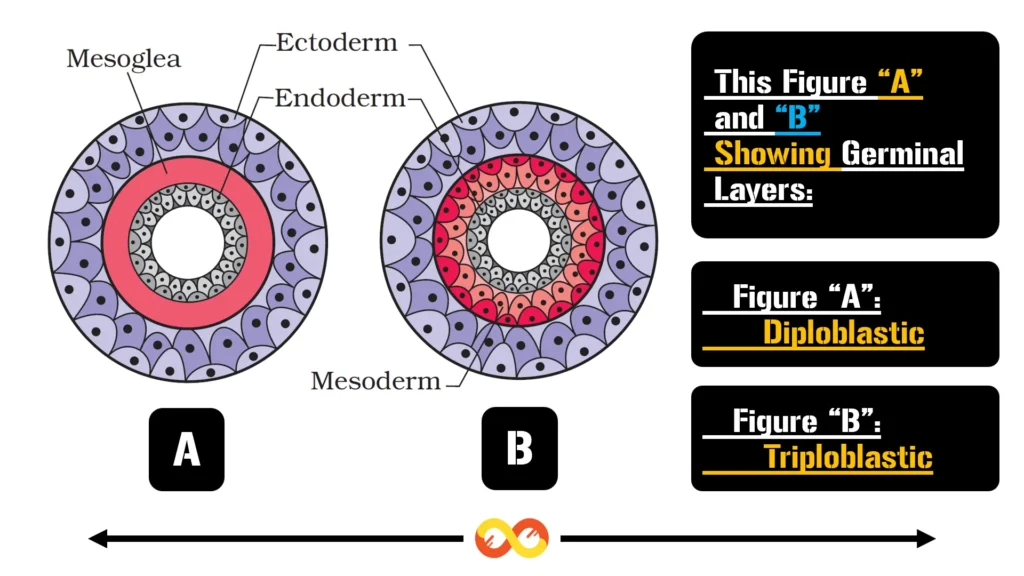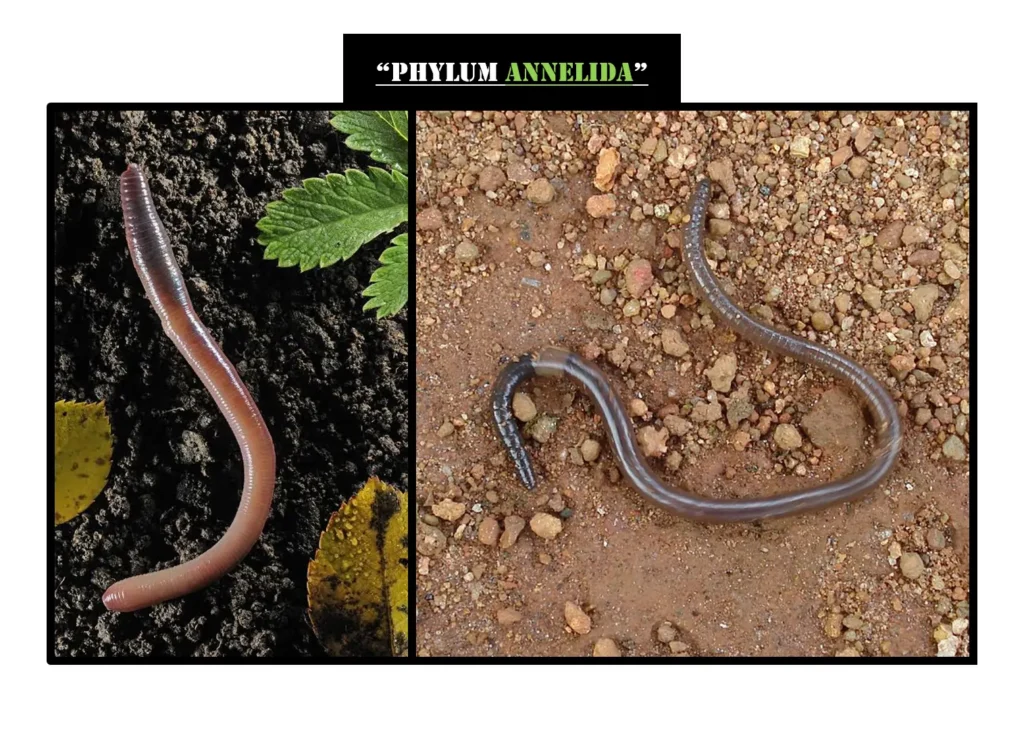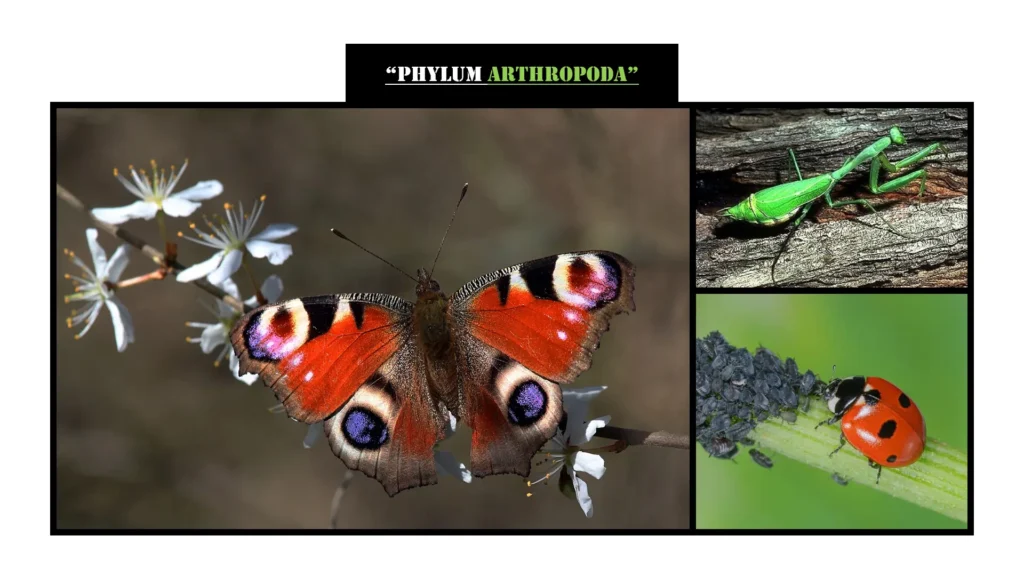Triploblastic animals represent a significant evolutionary milestone in the animal kingdom, showcasing an advanced level of biological organization. These organisms are defined by the presence of three germ layers—the ectoderm, mesoderm, and endoderm—which provide the foundation for the development of complex organs and systems. The structural and functional specialization made possible by this arrangement has enabled triploblastic animals to adapt to diverse environments and lifestyles.
Table of Contents
Key Features of Triploblastic Animals
Three Germ Layers
The defining characteristic of triploblastic animals is the presence of three germ layers formed during embryonic development. Each layer gives rise to specific structures and systems in the adult organism:

- Ectoderm:
- Forms the outer epithelial covering of the body, including the skin.
- Develops into the central nervous system (CNS), including the brain and spinal cord.
- Contributes to sense organs like the eyes and ears, allowing organisms to perceive and respond to their surroundings.
- Mesoderm:
- Gives rise to the skeletal system, which provides support and protection.
- Develops into the muscular system, enabling movement.
- Forms the circulatory system, including the heart and blood vessels, ensuring efficient transport of nutrients and oxygen.
- Produces connective tissues like cartilage and tendons.
- Endoderm:
- Develops into the digestive tract, ensuring the organism can process and absorb nutrients.
- Forms the lungs and other components of the respiratory system.
- Contributes to organs such as the liver, pancreas, and urinary bladder, which perform essential metabolic and excretory functions.
True Coelom
A majority of triploblastic animals possess a coelom, a fluid-filled internal body cavity entirely lined by epithelial tissue derived from the mesoderm. This cavity houses and protects vital organs, allowing them to function independently of the outer body wall. The coelom also facilitates more complex body movements, as seen in vertebrates and many invertebrates.
Bilateral Symmetry
Triploblastic animals exhibit bilateral symmetry, meaning their bodies can be divided into mirror-image halves along a single plane. This symmetry allows for streamlined movement and a more organized arrangement of body structures. Such organization is critical for efficient locomotion, enabling these animals to hunt, escape predators, and interact with their environment effectively.
Complex Nervous System
The development of a central nervous system (CNS) is a hallmark of triploblastic animals. This system enables advanced sensory perception, motor coordination, and behavioral responses. For example, vertebrates like humans possess highly developed brains capable of reasoning, learning, and memory, while invertebrates like octopuses demonstrate remarkable problem-solving abilities.
Categories of Triploblastic Animals
Triploblastic animals are further classified based on the presence and type of coelom, reflecting their evolutionary adaptations:
- Acoelomates:
- These animals lack a coelom, resulting in a solid body structure with minimal space for internal organ development.
- Example: Flatworms (Phylum Platyhelminthes), such as planarians, which rely on diffusion for nutrient and gas exchange due to the absence of circulatory and respiratory systems.
- Pseudocoelomates:
- These animals possess a pseudocoelom, a body cavity not fully lined by mesodermal tissue.
- Example: Roundworms (Phylum Nematoda), such as Ascaris, which have a simple body plan but demonstrate efficient movement and nutrient distribution through their pseudocoelom.
- Eucoelomates:
- True coelomates have a fully developed coelom, allowing for the formation of intricate organ systems.
- Example: Vertebrates like humans and invertebrates like earthworms and mollusks.
Examples of Triploblastic Animals
Vertebrates
- Humans and other mammals exhibit unparalleled complexity in their organ systems, enabling activities like reasoning and communication.
- Birds, such as eagles, showcase specialized adaptations like feathers and hollow bones for flight.
- Fishes, including sharks and salmon, demonstrate efficient locomotion and respiratory systems for aquatic environments.

Invertebrates
- Earthworms (Phylum Annelida) play a crucial role in soil aeration and nutrient recycling.
- Insects (Phylum Arthropoda) like bees and ants exhibit highly organized social behaviors and are essential for pollination.
- Mollusks, such as squids and clams, display diverse adaptations for movement, feeding, and protection.


Significance of Triploblastic Organization
The triploblastic body plan has profound implications for the evolution and success of animals:
- Efficient Transport Systems:
- The development of a circulatory system allows for rapid distribution of oxygen, nutrients, and hormones, ensuring that all cells function optimally.
- Specialized Organs:
- Organs like the heart, lungs, and kidneys enhance the ability of organisms to survive in diverse and challenging environments.
- Streamlined Movement:
- Bilateral symmetry provides a distinct advantage in mobility, allowing predators to chase prey effectively and prey to escape danger.
- Adaptability:
- The diversity in triploblastic animals, from simple flatworms to complex vertebrates, demonstrates their ability to adapt to various ecological niches.
- Ecological Impact:
- Triploblastic animals, particularly invertebrates like earthworms and insects, play pivotal roles in ecosystems by aiding in decomposition, pollination, and nutrient cycling.
Conclusion
Triploblastic animals epitomize the peak of biological complexity. The presence of three germ layers, a coelom, and advanced nervous systems has enabled these organisms to dominate nearly every habitat on Earth. From the soil-enriching earthworm to the cognitively advanced human, the evolutionary innovations of triploblastic animals underscore the incredible diversity and adaptability of life. Their study not only enhances our understanding of biology but also provides insights into the intricate web of life that sustains our planet.
Informative Table: Triploblastic Animals
This table {give below} condenses the key information in a structured and easy-to-read format, providing an overview of triploblastic animals, their features, categories, examples, and significance.
| Category | Details | Examples |
|---|---|---|
| Definition | Triploblastic animals have three germ layers—ectoderm, mesoderm, and endoderm—enabling the development of complex organ systems. | |
| Key Features | Three Germ Layers: – Ectoderm: Outer covering, CNS, and sense organs. – Mesoderm: Skeletal, muscular, and circulatory systems. – Endoderm: Digestive organs, lungs, liver. | |
| True Coelom: Internal cavity lined with epithelial tissue, protecting and housing vital organs. | Vertebrates, arthropods. | |
| Bilateral Symmetry: Streamlined body organization for efficient movement. | Fish, mammals, insects. | |
| Complex Nervous System: Advanced sensory and motor functions enabling interaction with the environment. | Octopuses, birds, humans. | |
| Categories | Acoelomates: – Lack of a coelom; solid body structure. – Relies on diffusion for nutrient and gas exchange. – Example: Flatworms (e.g., planarians). | Flatworms (Platyhelminthes) |
| Pseudocoelomates: – Have a false coelom; body cavity not fully lined with mesoderm. – Example: Roundworms (e.g., Ascaris). | Roundworms (Nematoda) | |
| Eucoelomates: – Possess a true coelom; supports complex organ systems. – Example: Vertebrates and invertebrates like earthworms. | Humans, earthworms, insects. | |
| Examples | Vertebrates: – Humans: Cognitive abilities and communication. – Birds: Adaptations for flight (e.g., feathers). – Fishes: Efficient aquatic locomotion and respiration. | Humans, eagles, salmon. |
| Invertebrates: – Earthworms: Soil aeration and nutrient recycling. – Insects: Pollination and ecological balance. – Mollusks: Diverse adaptations for survival. | Earthworms, bees, squids. | |
| Significance | Efficient Transport: Circulatory systems for nutrient and oxygen delivery. Specialized Organs: Enhanced survival through organ development (e.g., heart, lungs, kidneys). | Humans, vertebrates. |
| Streamlined Movement: Bilateral symmetry aids mobility for predators and prey. Adaptability: Enables survival in diverse environments. | Predators (e.g., lions), prey (e.g., deer). | |
| Ecological Roles: Essential for nutrient cycling (e.g., earthworms) and pollination (e.g., bees). | Earthworms, bees. |
Related Articles
- Animal Kingdom: A Comprehensive Exploration
- Classification of the Animal Kingdom: A Comprehensive Exploration
- Understanding Coelom Development: A Comprehensive Exploration
- Chordates: The Marvels of Biological Diversity, and its Detailed Exploration
- Non-Chordates: An In-Depth Comprehensive Exploration
- Phylum Porifera: Characteristics, and Examples of the Pore-Bearing Animals
- Phylum Coelenterata: The Simplest Group of Multicellular Invertebrates
- Phylum Ctenophora: The Marvels of Comb Jellies
- Phylum Platyhelminthes: Understanding the Fascinating World of the Flatworms
- Phylum Nematoda: Biology, Classification, Roles, and Its Significance
- Phylum Annelida: Characteristics and its Classification with Detailed Exploration
- Phylum Aschelminthes: The World of Pseudocoelomates
- Phylum Arthropoda: The Most Diverse Kingdom of Life
- Phylum Mollusca: Characteristics, Classification, and Its Significance
- Phylum Echinodermata: The Marvels of the Marine World
- Phylum Hemichordata: A Comprehensive Exploration of Marine Half-Chordates
- Levels of Organization in Animals: A Comprehensive Exploration
- Symmetry in Animals: Definition, Types, and Importance with Detailed Exploration
Video Links Related to this Article
- Diploblastic and triploblastic animal, Animal Kingdom class 11 biology
- Coelom animal kingdom overview for class 11
- Biology Animalia part 5 (Diploblastic & Triploblastic)
- Diploblastic, Triploblastic, Coelom, and Coelomate: Phylums of Animal Kingdom Part 3
Read More Articles
- The Living World
- Biological Classification
- The Evolution of Biological Classification Systems
- Kingdom Monera: The World of Bacteria
- The Diversity and Importance of Bacteria: Archaebacteria and Eubacteria
- Kingdom Protista: A Diverse Group of Single-Celled Eukaryotes
- Archaebacteria: A Glimpse into Ancient Life Forms
- Eubacteria: Structure, Characteristics, Classification, and Types
- The Five Kingdom Classification with Perfect Examples
- Ribosomes: The Cellular Machinery for Protein Synthesis
- Autotrophic Nutrition: An In-Depth Exploration
- Understanding the Cell Wall: Structure, Composition, and Function
- Chrysophytes: A Detailed Exploration of Their Classification, Characteristics, and Significance
- Dinoflagellates: The Whirling Protists of the Oceans
- Euglenoid: The Unique Plant-Animal Hybrid
- Slime Moulds: A Comprehensive Overview
- Protozoans: Structure, Classification, Characteristics, and Examples
- Kingdom Fungi: A Comprehensive Exploration
- Fungi: Definition, Characteristics, Classification, and Uses
- Phycomycetes: A Detailed Exploration of the Lower Fungi
- Ascomycetes – A Detailed Exploration of Characteristics, Reproduction, and Importance
- Basidiomycetes: A Comprehensive Study of Club Fungi
- The Deuteromycetes: A Comprehensive Study of Imperfect Fungi
- Kingdom Plantae: A Comprehensive Overview of the Plant Kingdom
- Kingdom Animalia: Definition, Classification, and Characteristics
- Biological Classification
- Exploring the Complex World of Viruses, Viroids, Prions, & Lichens
- Understanding the Plant Kingdom: A Comprehensive Exploration of Kingdom Plantae
- The Comprehensive Guide to Algae: Definition, Characteristics, Types, and Importance
- Comprehensive Overview of Chlorophyceae: Detailed Classification, Structure, & Reproductive Mechanisms
- Phaeophyceae: An In-Depth Exploration of Brown Algae
- Rhodophyceae: Comprehensive Guide to Ancient Red Algae of the Marine World
- Bryophytes: A Comprehensive Exploration of the Amphibians of the Plant Kingdom
- The Fascinating World of Liverworts: Structure, Habitat, and Reproduction
- Mosses: A Comprehensive Guide to its Biology, Classification, and Significance
- Pteridophytes: A Comprehensive Guide to its Characteristics, Classification, Life Cycle, and Importance
- Gymnosperms: Comprehensive Exploration of the Ancient Seed-Bearing Plants Without Flowers or Fruits
- The Wonders of Angiosperms: A Comprehensive Exploration of Flowering Plants
- Difference Between Gymnosperms and Angiosperms: A Comprehensive Guide
Frequently Asked Questions (FAQs) on Triploblastic Animals
What are triploblastic animals, and why are they considered a pinnacle of complexity?
Triploblastic animals are organisms that possess three germ layers—the ectoderm, mesoderm, and endoderm—which develop during embryonic growth. These germ layers are responsible for forming all the tissues and organs of the body.
- Ectoderm: This outer layer forms the skin, nervous system, and sense organs, including the eyes and ears. It allows these animals to interact with their environment, making them highly adaptive.
- Mesoderm: The middle layer forms the skeletal, muscular, and circulatory systems, along with connective tissues. This layer enables efficient movement and nutrient transport.
- Endoderm: The innermost layer forms the digestive tract, lungs, liver, and other internal organs, ensuring metabolic and excretory efficiency.
This complex organization enables triploblastic animals to develop specialized systems such as the nervous system, circulatory system, and respiratory system, which are absent in simpler organisms like diploblastic animals (e.g., jellyfish). These advanced features have allowed triploblastic animals to dominate a variety of ecosystems, from oceans to forests and deserts.
What is the significance of having three germ layers in triploblastic animals?
The three germ layers—ectoderm, mesoderm, and endoderm—are vital for the development of complex body structures and organ systems:
- Ectoderm: Creates external structures like skin and sense organs, providing protection and environmental awareness. The nervous system derived from this layer enables advanced sensory and motor responses.
- Mesoderm: Forms the muscles, bones, and circulatory system, allowing for movement, support, and nutrient transport. This layer also produces connective tissues that bind and support organs.
- Endoderm: Develops internal organs such as the digestive tract, ensuring efficient processing and absorption of nutrients, and the lungs, enabling respiration.
The development of these layers marked a significant evolutionary step, as it allowed for the specialization of cells, tissues, and organs, enabling triploblastic animals to adapt to complex environments and challenges.
What is a coelom, and how does it benefit triploblastic animals?
A coelom is a fluid-filled body cavity entirely lined by epithelial tissue derived from the mesoderm. It serves several vital functions:
- Protection: The coelom cushions internal organs, preventing damage from external forces.
- Organ Independence: It allows internal organs to grow and move independently of the body wall, enhancing flexibility and functionality.
- Efficient Movement: The coelom acts as a hydrostatic skeleton in some animals (e.g., earthworms), aiding movement and structural support.
Triploblastic animals with a true coelom, such as vertebrates, exhibit greater complexity in their body systems. For example, the digestive system and circulatory system are housed within the coelom, ensuring efficient nutrient distribution and waste removal.
How does bilateral symmetry benefit triploblastic animals?
Bilateral symmetry means the body can be divided into two identical halves along a single plane. This arrangement provides several advantages:
- Streamlined Movement: Bilateral symmetry allows for forward-directed movement, which is crucial for hunting, escaping predators, and exploring new environments.
- Cephalization: It leads to the concentration of sensory organs and the central nervous system (CNS) in the head region, enabling quick responses to stimuli.
- Organized Body Plan: Structures are arranged more efficiently, improving functionality. For instance, bilateral symmetry aids in better coordination of limbs in animals like mammals and birds.
This symmetry is a hallmark of advanced locomotion and predatory behavior, seen in animals like lions, fish, and birds.
How are triploblastic animals classified based on the presence of a coelom?
Triploblastic animals are classified into three categories based on the presence and type of coelom:
- Acoelomates:
- Lack of a coelom, resulting in a solid body.
- Example: Flatworms (e.g., planarians) rely on diffusion for nutrient and gas exchange.
- Significance: Their simplicity suits their parasitic or free-living lifestyles.
- Pseudocoelomates:
- Possess a pseudocoelom, a body cavity not fully lined by mesodermal tissue.
- Example: Roundworms (e.g., Ascaris) have a simple body plan with an efficient distribution of nutrients and waste.
- Eucoelomates:
- Have a true coelom, fully lined by mesodermal tissue.
- Examples: Vertebrates (e.g., humans) and invertebrates (e.g., earthworms, insects) exhibit highly developed organ systems.
What is the evolutionary significance of triploblastic animals?
The evolution of triploblastic animals marked a major leap in the complexity of life forms. Key aspects include:
- Increased Specialization: The three germ layers allowed for specialized organs and tissues, enabling advanced physiological functions.
- Efficient Systems: The development of systems like the circulatory, digestive, and nervous systems allows for survival in diverse environments.
- Complex Behaviors: Advanced nervous systems enable higher cognitive functions, complex social structures, and problem-solving abilities.
Triploblastic animals have radiated into nearly all ecological niches, from the deep sea to terrestrial habitats, showcasing their adaptability.
How do triploblastic animals contribute to ecosystems?
Triploblastic animals play vital roles in maintaining ecological balance:
- Decomposers: Earthworms improve soil quality by recycling nutrients.
- Pollinators: Bees and other insects facilitate plant reproduction, ensuring food security for ecosystems.
- Predators and Prey: They regulate populations, maintaining the food chain’s balance.
Without triploblastic animals, ecosystems would face imbalances that could disrupt nutrient cycles and food webs.
What are some real-life examples of triploblastic animals?
Triploblastic animals are incredibly diverse:
- Vertebrates:
- Humans: Possess advanced organ systems and cognitive abilities.
- Birds: Adaptations like feathers and hollow bones enable flight.
- Fishes: Efficient aquatic locomotion and respiration.
- Invertebrates:
- Earthworms: Aerate soil and decompose organic matter.
- Insects: Pollinate crops and form essential links in food chains.
- Mollusks: Squids and clams exhibit diverse survival strategies.
How does the nervous system in triploblastic animals enhance their survival?
The nervous system in triploblastic animals is typically more advanced, allowing for:
- Sensory Perception: Specialized sense organs detect environmental changes.
- Motor Coordination: Complex movements are facilitated by coordinated nerve and muscle functions.
- Behavioral Adaptations: Advanced brains (in animals like humans and octopuses) enable learning, memory, and problem-solving.
These capabilities allow triploblastic animals to adapt to diverse habitats and respond effectively to threats and opportunities.
Why are triploblastic animals considered a cornerstone of biodiversity?
Triploblastic animals form the backbone of terrestrial and aquatic ecosystems. Their biodiversity, ranging from simple flatworms to complex mammals, demonstrates their evolutionary success. Key contributions include:
- Ecosystem Services: Nutrient cycling, pollination, and pest control.
- Economic Importance: Sources of food, medicine, and materials like silk and honey.
- Scientific Study: Insights into evolution, genetics, and physiology.
Their adaptability and complexity have made triploblastic animals a cornerstone of life on Earth, driving ecological and evolutionary dynamics.
What role does the mesoderm play in the development of triploblastic animals?
The mesoderm, one of the three germ layers in triploblastic animals, plays a pivotal role in forming the structures and systems that define their complexity:
- Skeletal System: The mesoderm gives rise to bones and cartilage, which provide structural support, protect internal organs, and enable movement. For instance, the human skeleton protects vital organs like the brain and lungs.
- Muscular System: Muscles, derived from the mesoderm, enable locomotion, posture, and other essential bodily movements. For example, the cardiac muscle, unique to the heart, is responsible for pumping blood throughout the body.
- Circulatory System: The heart, blood vessels, and blood originate from the mesoderm. This system ensures the efficient transport of oxygen, nutrients, and waste products, which is essential for the survival of larger, more complex organisms.
- Excretory System: Organs like the kidneys and bladder, which filter waste and regulate fluid balance, also develop from the mesoderm.
The mesoderm enables the formation of specialized tissues that are essential for the complex and dynamic lives of triploblastic animals, allowing them to adapt to various habitats and ecological roles.
How does the endoderm contribute to the survival and efficiency of triploblastic animals?
The endoderm, the innermost germ layer, is responsible for forming the internal organs that are essential for metabolism, respiration, and excretion. Key contributions of the endoderm include:
- Digestive System: The endoderm develops into the gastrointestinal tract, including the stomach, intestines, and associated glands like the pancreas. These organs enable the breakdown and absorption of nutrients, providing energy for growth and survival.
- Respiratory System: The lungs and other respiratory structures originate from the endoderm, facilitating efficient gas exchange. For instance, in mammals, the lungs provide oxygen to the bloodstream and remove carbon dioxide.
- Liver and Pancreas: The liver, which produces bile and detoxifies harmful substances, and the pancreas, which regulates blood sugar through hormones like insulin, are both endodermal derivatives.
- Urinary System: The urinary bladder, also derived from the endoderm, plays a role in excretion and maintaining fluid balance.
The endoderm’s role in forming internal organs is crucial for maintaining homeostasis, enabling triploblastic animals to thrive in diverse environments, from aquatic to terrestrial ecosystems.
What distinguishes eucoelomates from pseudocoelomates and acoelomates, and why is this distinction significant?
Triploblastic animals are classified based on the type of body cavity they possess, and this classification significantly impacts their complexity and functionality:
- Acoelomates:
- Lack a body cavity (coelom), with their bodies being solid between the gut and the outer body wall.
- Example: Flatworms (e.g., planarians).
- Limitations: Without a coelom, they rely on diffusion for nutrient and gas exchange, restricting their size and complexity.
- Pseudocoelomates:
- Have a pseudocoelom, a cavity partially lined by mesoderm.
- Example: Roundworms (e.g., Ascaris).
- Adaptations: The pseudocoelom provides space for internal organs and a simple distribution system for nutrients and wastes.
- Eucoelomates:
- Possess a true coelom, fully lined by mesodermal tissue.
- Examples: Vertebrates (e.g., humans) and invertebrates (e.g., insects, mollusks).
- Advantages: The true coelom allows for the development of complex organ systems, efficient movement, and greater flexibility.
The evolution of a true coelom in eucoelomates has enabled the development of larger, more mobile, and more adaptive animals, marking a significant evolutionary milestone.
How do triploblastic animals adapt to diverse environments?
Triploblastic animals have evolved several features that allow them to thrive in varied environments, including terrestrial, aquatic, and aerial habitats:
- Bilateral Symmetry: This feature enables streamlined movement, essential for swimming (e.g., fishes), running (e.g., cheetahs), or flying (e.g., birds).
- Advanced Nervous System: A centralized nervous system (CNS) allows them to process complex stimuli, aiding in navigation, predation, and social behaviors. For instance, dolphins use echolocation to locate prey in murky waters.
- Respiratory Adaptations: Triploblastic animals exhibit diverse respiratory mechanisms suited to their environments:
- Aquatic animals (e.g., fish) use gills for oxygen exchange.
- Terrestrial animals (e.g., mammals) have lungs optimized for air breathing.
- Specialized Limbs: Adaptations like fins, wings, and legs enable movement in specific environments. Birds, for instance, have hollow bones and wings for flight, while whales have flippers for swimming.
- Excretory Efficiency: Organs like kidneys and bladders regulate waste and water balance, essential for survival in arid regions or salty waters.
These adaptations have allowed triploblastic animals to occupy a wide range of ecological niches, showcasing their evolutionary success.
What is the ecological importance of triploblastic invertebrates and vertebrates?
Triploblastic animals, both invertebrates and vertebrates, play critical roles in maintaining ecological balance:
- Invertebrates:
- Pollinators: Insects like bees and butterflies are vital for pollinating crops and wild plants, supporting food webs and biodiversity.
- Decomposers: Earthworms and other detritivores break down organic matter, recycling nutrients back into the soil.
- Pest Control: Predatory insects like ladybugs control pest populations, reducing the need for chemical pesticides.
- Vertebrates:
- Keystone Species: Predators like wolves regulate prey populations, preventing overgrazing and maintaining ecosystem health.
- Seed Dispersers: Birds and mammals spread seeds, aiding forest regeneration.
- Marine Ecosystem Balance: Fish and marine mammals contribute to nutrient cycling in aquatic ecosystems.
The loss of triploblastic species can have cascading effects on ecosystems, emphasizing the importance of conserving these animals for ecological stability and sustainability.
